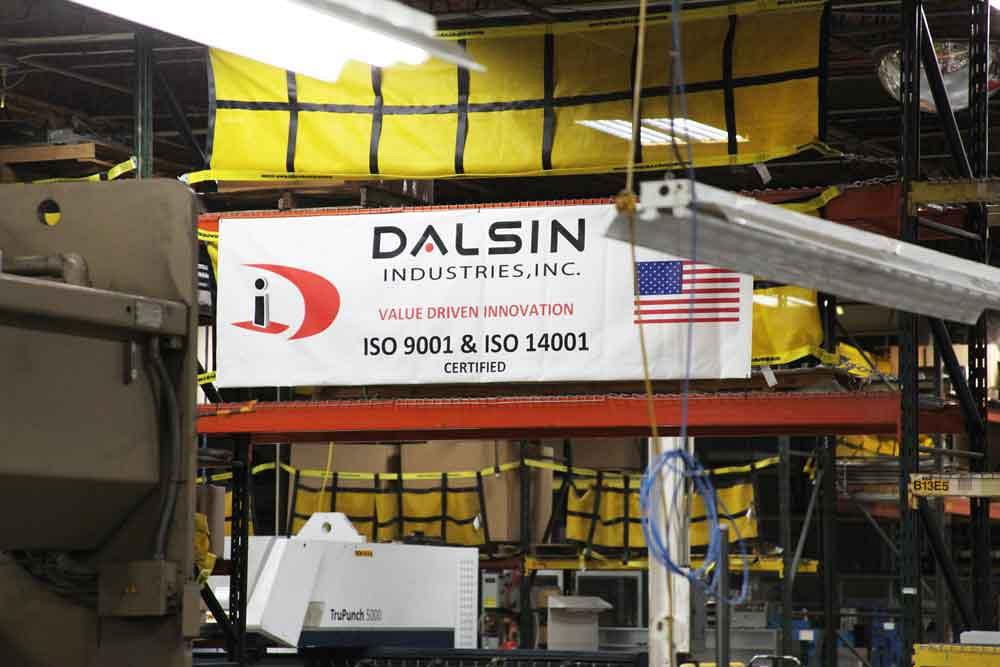Editor-in-Chief
- FMA
- The Fabricator
- FABTECH
- Canadian Metalworking
Categories
- Additive Manufacturing
- Aluminum Welding
- Arc Welding
- Assembly and Joining
- Automation and Robotics
- Bending and Forming
- Consumables
- Cutting and Weld Prep
- Electric Vehicles
- En Español
- Finishing
- Hydroforming
- Laser Cutting
- Laser Welding
- Machining
- Manufacturing Software
- Materials Handling
- Metals/Materials
- Oxyfuel Cutting
- Plasma Cutting
- Power Tools
- Punching and Other Holemaking
- Roll Forming
- Safety
- Sawing
- Shearing
- Shop Management
- Testing and Measuring
- Tube and Pipe Fabrication
- Tube and Pipe Production
- Waterjet Cutting
Industry Directory
Webcasts
Podcasts
FAB 40
Advertise
Subscribe
Account Login
Search
How one metal fabricator stays agile
Dalsin Industries makes change a core competency to keep pace with market realities and earn The FABRICATOR’s 2020 Industry Award
- By Dan Davis
- February 3, 2020
- Article
- Shop Management

The executive team that leads Dalsin Industries comprises (front row, from left) Mark Coronna, chief marketing officer; Lynee Jacobucci, director of finance; Gary Fruth, president; Sharla Wagy, general manager, Memphis Wood Fire Grills; (back row, from left) Bob Borgerding, vice president, production operations; Keith Diekmann, vice president, technical operations; and Tom Schmeling, vice president, sales. Photos courtesy of Matt Osterman, Propellant Media.
Change is never easy, but not changing can be worse. Luckily, keeping up with change can help an organization become better at it. After all, practice makes perfect.
Dalsin Industries, Bloomington, Minn., has done that over its 75 years, particularly in the latter part of the company’s history. The business, founded by Richard and Eleanor Dalsin in 1945 as Dick Dalsin Sheet Metal, began as a supplier of architectural products to the roofing industry. In the late 1970s and early 1980s, Dalsin Industries turned its attention to the precision sheet metal business and connected with some customers that were on the verge of robust growth. By the mid-1980s, company leaders knew that they had a real opportunity to transform the business serving these much larger customers, and they doubled down on automated equipment and new fabricating technology. The focus on roofing products grew smaller and smaller, and Dalsin Industries became more of a traditional sheet metal job shop, serving customers in a variety of industries and fabricating parts of varying complexity and volumes.
“I’ve been here more than 25 years, so obviously the company has changed dramatically over that period of time,” said Gary Fruth, Dalsin Industries’ president. “We have seen a lot of change.”
Change is inevitable as you try to meet customers’ demands over the many industry segments being served. Customers in the bus and recreational vehicle, construction, outdoor power equipment, and agriculture segments all have different quality and delivery requirements, but they all want parts within tolerance and delivered on time. Even those customers from industries that might not be as active at the moment, such as solar companies, have permanently influenced the way Dalsin Industries conducts business today.
“One of the things that makes our industry really interesting is the fact that we have to constantly change and evolve, anticipating the needs of what’s going to happen in the marketplace,” Fruth said. “We have to stay close to our customers so that we can stay relevant and help them achieve their business goals.”
That approach to embracing change has led the metal fabricator to enjoy robust growth over the past couple of years, achieving 20% in 2019 and 25% in 2018. Company officials believe its projected three-year growth rate is two times that of the industry average.
How the fabricator has grown its business and kept up with the organizational challenges that fast growth creates are some of the reasons that The FABRICATOR has given its 2020 Industry Award to Dalsin Industries. Agility is the key to survivability.
Keeping up With the Customers
If you have the chance to meet with representatives of Dalsin Industries at their Bloomington facility, you might find yourself in their executive conference room. There you will be surrounded by several metal parts and assemblies, all examples of the company’s metal fabricating expertise.
Dalsin Industries has taken advantage of the OEM trend of focusing on final assembly. As many product line manufacturers are streamlining their manufacturing operations in favor of relying on key suppliers of metal fabricating services, Dalsin Industries has been more than willing to take on the production responsibility.
Doing so means that the fabricator has assumed more of a partnership role with these OEM customers. Dalsin Industries isn’t just producing to the print in these instances; it is actively involved in part design.

The TruPunch 5000 punching machine from TRUMPF, with its automated material load/unload and part sorting capability, is an example of the automated fabricating technology that has enabled Dalsin Industries to remain cost-competitive in the face of global competition.
“When we can take a customer’s current design and re-engineer it, it really puts us in a good light and a good position for the customer,” said Keith Diekmann, vice president, technical operations.
“This allows us to provide them with the best way to fabricate the part, reduce the cost of making the part, and deliver a high-performance part,” Diekmann continued. “The customer knows that piece of sheet metal is going to do exactly what they need it to do to meet their product specifications.”
The fabricator regularly flexes its engineering muscles to ensure that it remains a valuable partner in what it hopes are long-term relationships. As an example, Diekmann described a three-part aluminum assembly for a commercial bus application. The original part was a tube assembly with a sheet metal skin, comprising seven pieces total. The Dalsin Industries engineers redesigned it and reduced the number of pieces in the assembly to three. The bus door also now can be formed on the company’s automated Salvagnini panel bender. The result was a major cost reduction for the customer and an overall weight reduction of 25%, which helps with maximizing gas mileage.
Mark Coronna, the company’s chief marketing officer, said this type of relationship is beneficial to both parties in the supply chain. The OEM customer can focus on the end product and serving its customers, and the fabricator can focus on the design of the parts, fabricating them as efficiently as possible according to specs and delivering them on time.
“It also makes business more fun and interesting when you get that kind of collaborative approach, where you’re sharing information back and forth,” Coronna said.
As Dalsin Industries strives to take on more manufacturing responsibility for its customers, it’s learning how to do so without assuming too much risk. Obviously, even a 135,000-square-foot facility is a finite space, and the company can’t expand the building every time new opportunities arise. Adding capacity has to be carefully considered because of the planning and investment required.
Working with a solar company about five years ago taught the company that a network of manufacturing partners, including some outside of North America, allows it to be responsive to almost anything its customer base can throw at it. Roll forming, stamping, and almost anything else that Dalsin Industries can’t do or just doesn’t have the capacity to do can be handled by what the company calls its Global Fabrication Supply Chain Program.
“It’s been a good program for us,” said Diekmann, who was instrumental in helping set up the global network of manufacturing partners. “It allows us to grow with the customer, from a design to a development prototype to initial runs and then into those really high volumes.
“It also allows access to a richer set of capabilities,” he continued. “For example, we can go from a conventionally formed part on a press brake to a roll formed part where we get the tooling made and just make miles and miles of something.”
That’s what happened when the fabricator was working with a solar company needing assistance to redesign its solar panel mounts—and reduce manufacturing costs as well. Dalsin Industries helped with the redesign and setup of manufacturing in China, where the mounts were roll formed before being sent back to the U.S.

Dalsin Industries upgraded its laser cutting capabilities with the installation of a 4-kW ML 3015SR-F-40 fiber laser from Mitsubishi/MC Machinery Systems in the spring of 2019. This machine joins an older 4-kW CO2 laser cutting machine that is attached to an automated storage and retrieval tower where the sheet metal is stored, allowing both units to run unattended. The company also has another stand-alone 4-kW CO2 laser cutting machine that is not attached to a material tower.
“We started this because we needed access to other capabilities that we didn’t have. It’s ended up helping us to grow the business as we extended this program to other customers,” Coronna said.
This approach might seem a little out of sync with current headlines. Aren’t tariffs on imported goods cooling global sourcing of fabricated products? Not necessarily. Remember that the tariffs are only targeting certain goods and certain countries.Diekmann said that its global sourcing program involves partners from all over the world, not just China. Dalsin Industries has connections with firms in South Korea, Vietnam, Canada, Portugal, and Spain. If a customer demands domestic manufacturing, the fabricator can reach out to its U.S. partners.
Five highly requested fabrication services make up the core of this program:
Heavy-gauge roll forming (up to 5 gauge)
Light-gauge roll forming with specialty coated materials
Robotic welded assemblies
Precision stamping coupled with internationally sourced tooling
Coatings, such as hot-dipped galvanized, e-coat, powder coat, or epoxy
With the network in place, Dalsin Industries can scale with the project, from prototype to high-volume run. Production integrity is ensured through detailed manufacturing process reviews and strong quality control plans. It can handle manufacturing operations and logistics, so the product can be delivered from anywhere in the world.
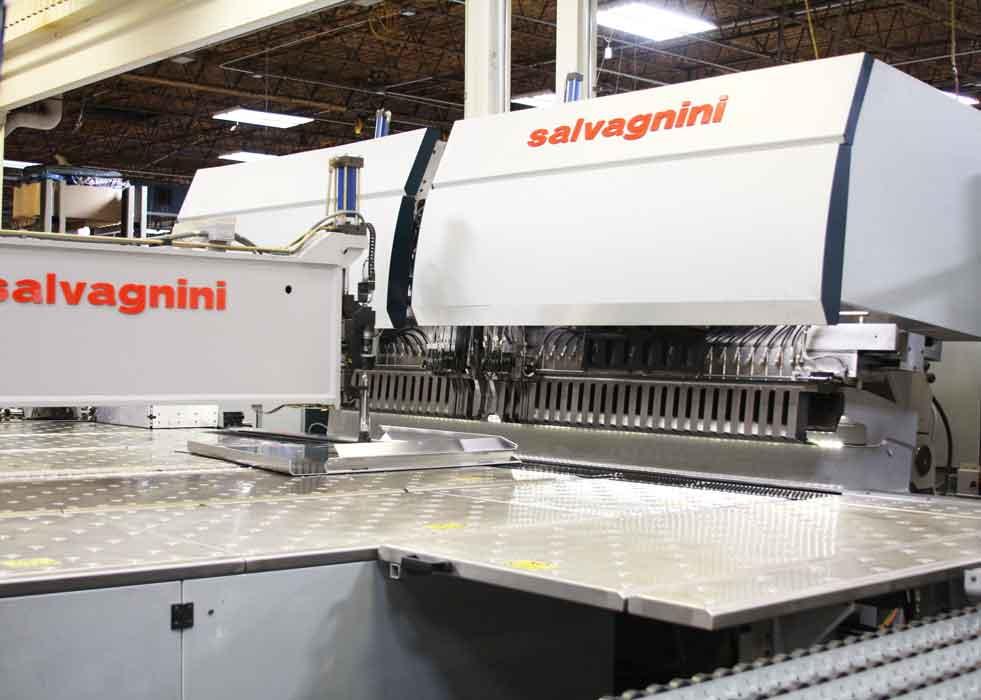
Dalsin Industries was an early adopter of automated panel bending technology, having purchased its first Salvagnini machine in the mid-1990s. It invested in a new system in 2018, which includes an automated material flipper to get the most out of the bending system without human intervention.
“This has really opened our eyes to the rest of the world,” Diekmann said. “You get to see the different ways to manufacture things. Your first assumption may be to consider automation and robotics, but sometimes it can be done with simple tooling and craftsmanship. There’s a whole lot to be learned out there.”
Making the Right Technology Investments
Working with a customer base that is familiar with the phrase “global price” or “low-cost country,” Dalsin Industries knows it has to be aware of costs. Fortunately, this is not a recently learned lesson. As it developed its first manufacturing relationships in its early years, the company knew the latest fabricating technologies would provide it with manufacturing efficiency and capabilities that its competitors would be hard-pressed to match.
For instance, the fabricator purchased its first Salvagnini automated panel bender in 1995. Over the years it has upgraded the equipment, with the latest installation of a Salvagnini P4 automated sheet metal panel bending system occurring in 2018.
Such equipment is useful in making boxes and enclosures, but Dalsin Industries has had success in getting customers to look beyond that—getting them to rethink how their parts might be fabricated. That’s led to things like panels for computer chassis, heat exchangers, and vending machines; tool drawers and lockers, vehicle door panels; metal furniture; light fixtures; refrigeration equipment; appliance doors and panels; and floor and ceiling systems being made on the panel bender instead of relying on skilled operators standing in front of a press brake to form them. The panel bender also can handle surface-sensitive materials, such as polished stainless steel and prepainted aluminum and steel.
“We understand the technology very well. We know how to make the equipment do things that maybe others don’t,” said Bob Borgerding, vice president, production operations.
The same agility can be applied to the company’s punching capabilities. While some metal fabricators may view punching as a staple in job shops of yesteryear, Dalsin Industries sees value in the technology even today. The company’s engineers are well-versed in the technology and know that they can produce part features on the TRUMPF TruPunch 5000 punching machine instead of relying on downstream processes to create them. They know that the punching machine can form, edge roll, roll offset flanges, countersink, counterbore, emboss, louver, extrude, tap, hinge barrel punch form, deburr, part mark, and etch. For those customers that might be concerned about the burrs sometimes associated with punching, the fabricator employs a cylindrical wheel with 45-degree angle that follows the punched part’s outer edge, eliminating the burr during the punching operation. In addition, Dalsin Industries maintains a regimented maintenance program for its punching tooling, keeping tools sharp and alignments precise for punching and extruding.
Labor costs are minimized with its punching operations as well. Material is automatically fed into the punching machine from a nearby storage tower, and parts are fed onto a conveyor or into bins, minimizing the need for a dedicated parts sorter.
“We need to stay current and relevant, looking forward to where the marketplace is going and what our customers’ needs may be,” Borgerding said. “We know that in order to run alongside our customers as their businesses change and evolve, we have to make those investments that can provide the right solution when they’re ready for it.”
That thinking led Dalsin Industries to take a step into an area some other fabricators have yet to go: 3D printing. It purchased a Fortus 3D printer from Stratasys six years ago with the intention of figuring out what additive manufacturing might mean to a metal fabricator. It has been a real educational experience, to say the least.
“We just started making parts to learn about the technology, and we ended up making parts for a lot of things that were causing us pain,” Diekmann said.
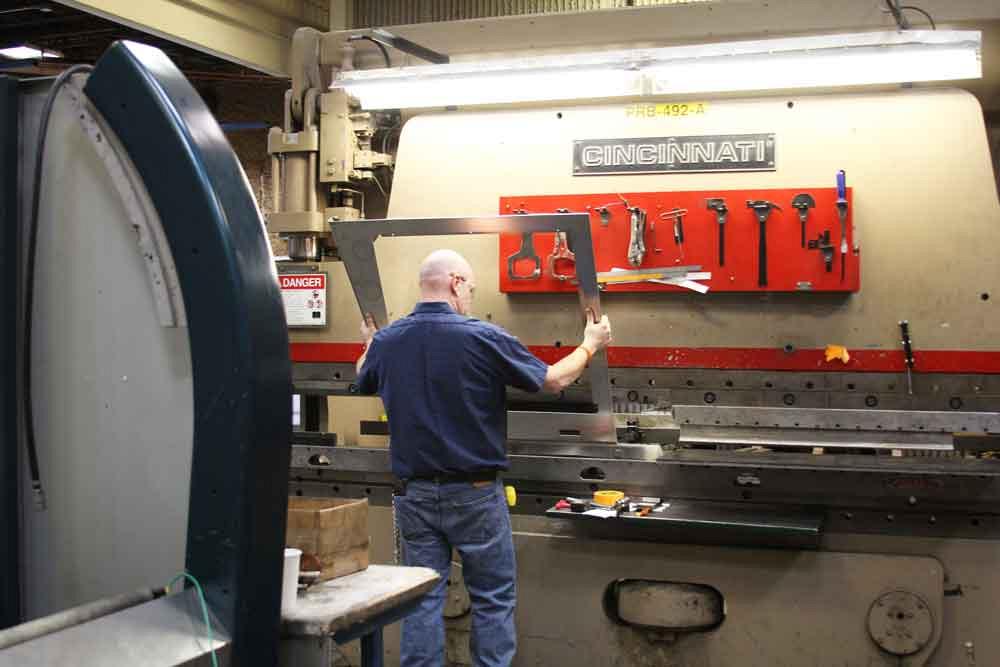
To ensure that press brake operators are spending their valuable time bending parts on the company’s Cincinnati press brakes, programmers create the bending jobs offline in the front office.
One of the first areas to be targeted was quality. Quality checks could prove to be a drawn-out process, particularly for new parts, because of delays related to fixture creation and scheduling. The 3D printer remedied both of those problems. Instead of waiting on the machining department to create the fixtures, quality personnel now just print them out, using original part specs to ensure all tolerances for the fixture are met. The fixtures can be created in hours instead of days. When it comes to actually creating the program for checking out first-part pieces, quality personnel now use 3D-printed parts that have the exact same shape as the metal parts that will be fabricated to create the coordinate measuring machine program. When they get a part for a quality check, they can call up the program because it’s already been created. Waiting for part approval is now much quicker than before.
Diekmann said that they haven’t figured out a way to integrate additive manufacturing into actual production parts, but that won’t prevent them from entertaining the thought. With more experience comes more familiarity, and that feeds the imagination. He said a generation of design engineers are growing up with desktop 3D printers and that is likely to change the way they approach product design. When that generation starts specifying 3D parts for their products, Dalsin Industries will be ready to deliver them.
Maintaining a Culture OK With Change
It’s one thing to introduce new processes and technology to the shop floor. It’s another to ensure that those processes are embraced and the technology utilized to its fullest capabilities. Change can occur only if the people affected by it are open to it.
To make all 148 employees feel a part of the same team, Dalsin Industries relies on communication. Sometimes it’s in the form of face-to-face meetings and other times through visual dashboards and individual employee scorecards.
Perhaps the most obvious method is the company’s advisory council, made up of representatives from all levels of the organization, but mostly those who actually “touch” the orders throughout the day, Fruth said.
One recent project that came their way was reworking the company’s mission statement. The council came up with this updated draft: “We integrate tools, technology, and talent to provide world-class precision metal products.”
“They then presented this at the monthly all-employee meeting,” said Lynee Jacobucci, director of finance. “Because it’s a mix of people from throughout the organization, it really sends a very strong message that we can all make a difference here.”
The advisory council also is a conduit for ideas from all employees. The council members formally present these ideas to the executive team.
At the executive level, all ideas worthy of action are graded and assigned a risk priority number. The higher the number, the more likely it will make the “project list.” They are the projects that are considered to be the best use of the company’s time and resources.
Fruth said the intent of the grading system was to have a transparent objective process that could be communicated at the monthly employee meetings. Everyone can see what the company is working on in the near term and what remains on the to-do list.
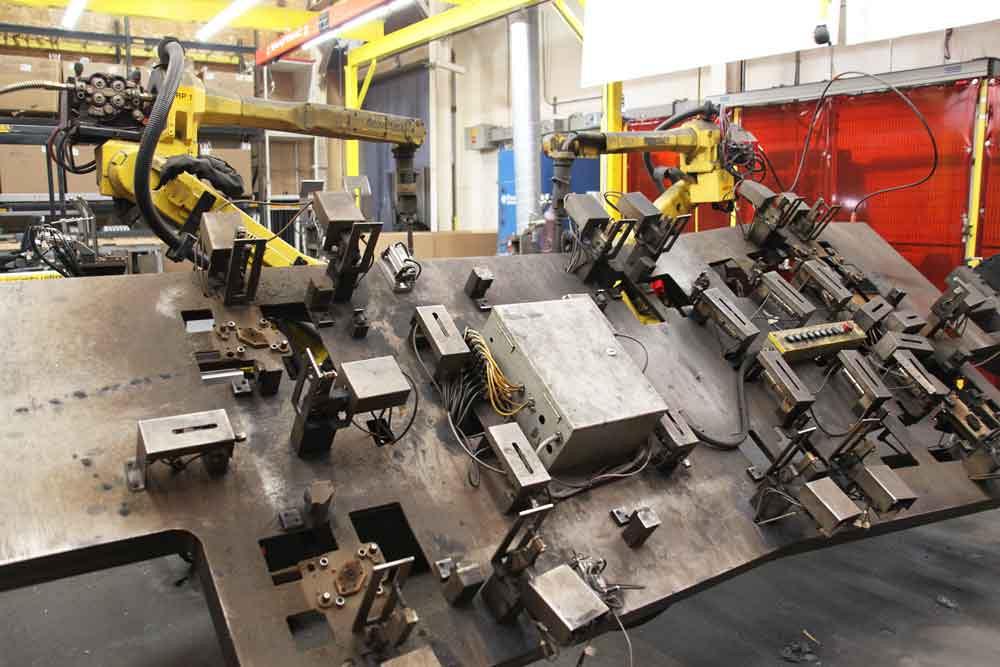
Dalsin Industries engineers have created some very sophisticated fixtures for the robotic welding cells, which include FANUC robots and Lincoln Electric power sources. Some, like this fixture, have PLCs and sensors that can open and shut automatically to allow welding guns on the robots to reach areas that may have previously been obscured by the clamps.
“The visual is important,” Fruth said. “They see what we’re working on with the company’s limited resources and if their idea isn’t currently being addressed, hopefully over time it will rise to the top. By the way, they can also see projects that may have the support of the CEO that aren’t currently being worked on either.”
Method engineering change requests are another way for employees to offer suggestions to improve a process. They can fill out the form and submit it to the director of continuous improvement, who then applies a grading scale to decide what should be acted upon first.
As of early December, Diekmann said that Dalsin Industries had about 67 projects in the “parking lot” awaiting action and about four active continuous improvement projects underway.
“We believe in all of our employees. We want to encourage them to share ideas. We take that seriously as a company,” Fruth said. “They need to feel like they have an opportunity to contribute.”
To foster that culture, the fabricator likes to promote from within when it can. Internal candidates have a knowledge of how things are done and a familiarity with the company’s metal fabricating technology and customers.
Training helps to produce well-rounded candidates from within the company who might otherwise be overlooked as future leaders. Borgerding said that employees are offered access to business skills and leadership development courses to prepare them for the challenges that await managers and supervisors.
“This way we have a feeder program for the future,” Borgerding said. “This kind of train-the-trainer mentality is a big component of how we try to get the skill sets we need for the organization.”
Launching a Successful Product Line
A metal fabricating company with a product line is not that unusual. It’s a chance to diversify revenue sources, and it helps to balance out work on the shop floor, particularly for those shops that serve customers in seasonal businesses.
Dalsin Industries is no different. Its product line is a big hit, however.
The company had fabricated and marketed a line of snow rakes for roofs and fire rings in the 2000s. It sold enough products, but it was not a “substantial” business, Fruth said.
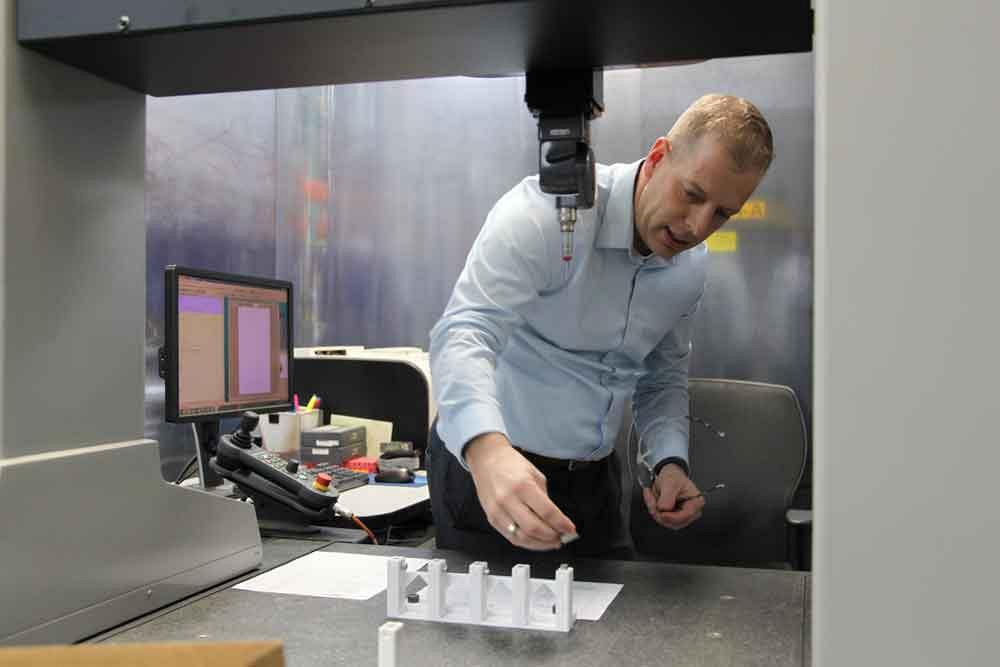
One of the ways that the fabricator is using its 3D printing capability is to create fixtures on which parts can be placed prior to scanning with its coordinate measuring machine.
The company got more serious about a proprietary product line as it planned to enter the pellet grill and stove market more than a decade ago. This was during a period when U.S. companies were sending a lot of metal manufacturing to overseas locations. A company like Dalsin Industries that took pride in its design capabilities, prototyping, and production abilities was losing out on this fabricating work in some instances.
“We wanted to do something to control our own destiny a little bit more, so we looked at ways that we could leverage the things that we’re good at already, which was sheet metal fabricating and developing a business opportunity that could take advantage of that capability,” Fruth said.
“We took the core competencies that we had in stainless steel fabrication and engineering knowledge, and we were able to develop a very high-end pellet grill,” said Sharla Wagy, general manager of the Memphis Wood Fire Grills business. “That was our start in the business.”
The debut of the grill at the 2010 Hearth, Patio & Barbecue Association Expo was a successful one. The grill was named “Best in Class,” competing against all the products in the outdoor category.
The timing couldn’t have been better for Dalsin Industries. Trends suggest consumers are more likely to purchase pellet grills more regularly than other types of cooking devices, and sales have grown consistently over the years, according to research firm IBISWorld. Worldwide revenue in this segment is expected to reach an estimated $7.2 billion by 2022. Pellet grills are grabbing a larger chunk of that pie with each passing year, dwarfing the growth of gas and charcoal grill sales. The technology serves up the ability to sear meat at high temperatures, commonly associated with gas grills, and smoke meat at lower temperatures for long-duration cooks, like a charcoal grill. Each Memphis Wood Fire Grill line also has a computer-controlled thermostat, convection fans for roasting or baking, and a Wi-Fi remote control. The latter feature won Dalsin Industries the 2016 Minnesota Manufacturing Award in the “Best New Product-General” category.
Borgerding said the grill business not only has been good for Dalsin Industries’ overall bottom line, but also company morale. Because most employees have a Memphis Wood Fire Grill at home, they—and their family and friends—always have a reminder of what the metal fabricating company can create. But it’s not just a visual reminder; everyone is putting their grills to use.
“It’s really been a way for us to unite the organization and pull it together culturally because we have a shared similar experience with the product,” Borgerding said.
Wagy said that the Memphis Wood Fire Grills unit has doubled revenue over the last four years and continues to seek out strong retail partners across North America. The company has seen strong growth in the built-in segment, where homeowners are looking for products that can be permanently placed in outdoor kitchens. Wagy said the company responded by not only designing grills that can fit these types of islands, but also high-end stainless steel cabinets and drawers to accompany the grills, all of which fit Dalsin Industries’ fabricating capabilities perfectly. The company also launched the Memphis Beale Street model, a smaller, nimbler, less expensive version of the Memphis Pro and Elite models, recently.
“We’ll be rolling out at least one new product in 2020,” Wagy said. “In the meantime, we’re still working on innovative features and improving the product.”
Preparing for What Comes Next
As Dalsin Industries looks to the future, its does so with confidence born of years of experience, recent successes, and a team that continues to rise to the occasion. Surprises are certain, but they won’t throw the company off course.
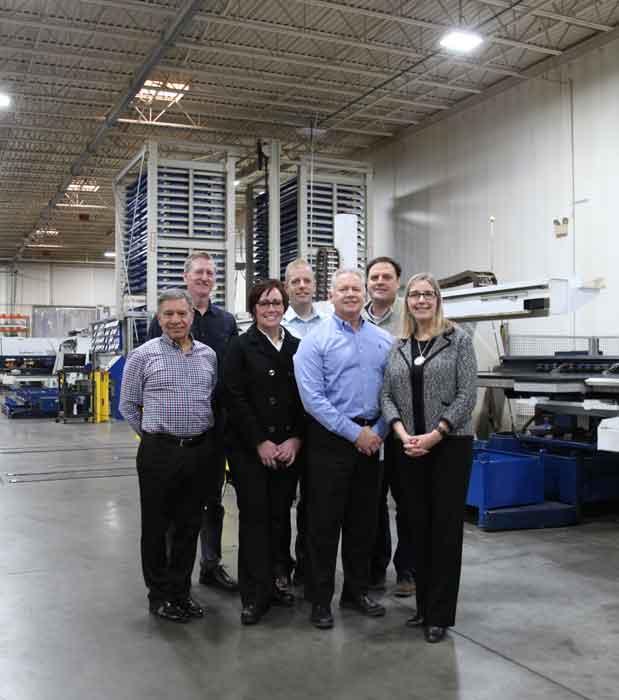
The executive team that leads Dalsin Industries comprises (front row, from left) Mark Coronna, chief marketing officer; Lynee Jacobucci, director of finance; Gary Fruth, president; Sharla Wagy, general manager, Memphis Wood Fire Grills; (back row, from left) Bob Borgerding, vice president, production operations; Keith Diekmann, vice president, technical operations; and Tom Schmeling, vice president, sales. Photos courtesy of Matt Osterman, Propellant Media.
The company’s strategic initiatives revolve around those activities that have helped to create a foundation for continued growth: diversification, continuous improvement activities, new technology investment, and attracting and retaining a quality workforce. Discipline will help Dalsin Industries get there.
For example, the fabricator literally can make almost anything. That doesn’t mean it’s interested in doing that. Dalsin Industries wants a certain type of customer, not just any customer.
Who is that specifically? It’s mostly large OEMs that are interested in value-added services and can provide repeatable business. These are customers that the metal fabricator can growth with, according to Tom Schmeling, vice president of sales. The rest of the business might be smaller customers that have the right jobs, albeit in smaller volumes, or larger customers with projects that are temporary in nature but big in scope.
“Managing that queue is one of the key success factors in this business,” Schmeling said.
Again, discipline helps to keep Dalsin Industries responsive. With better and long-term customer relations comes better planning and forecasting. With better knowledge of what is to come, the fabricator can plan for equipment investment and manufacturing capacity commitment for the coming year. That influences the development of activities to support the overall strategic initiatives. Dalsin Industries shouldn’t be caught flat-footed, barring some unforeseen event that catches everyone by surprise.
“A lot of people who don’t understand this industry do not realize how complicated running and growing a business like this really is,” Coronna said.
Agility helps to offset the unpredictability.
About the Author

Dan Davis
2135 Point Blvd.
Elgin, IL 60123
815-227-8281
Dan Davis is editor-in-chief of The Fabricator, the industry's most widely circulated metal fabricating magazine, and its sister publications, The Tube & Pipe Journal and The Welder. He has been with the publications since April 2002.
subscribe now

The Fabricator is North America's leading magazine for the metal forming and fabricating industry. The magazine delivers the news, technical articles, and case histories that enable fabricators to do their jobs more efficiently. The Fabricator has served the industry since 1970.
start your free subscription- Stay connected from anywhere

Easily access valuable industry resources now with full access to the digital edition of The Fabricator.

Easily access valuable industry resources now with full access to the digital edition of The Welder.

Easily access valuable industry resources now with full access to the digital edition of The Tube and Pipe Journal.
- Podcasting
- Podcast:
- The Fabricator Podcast
- Published:
- 04/16/2024
- Running Time:
- 63:29
In this episode of The Fabricator Podcast, Caleb Chamberlain, co-founder and CEO of OSH Cut, discusses his company’s...
- Trending Articles
Capturing, recording equipment inspection data for FMEA

Tips for creating sheet metal tubes with perforations

Are two heads better than one in fiber laser cutting?

Supporting the metal fabricating industry through FMA

Hypertherm Associates implements Rapyuta Robotics AMRs in warehouse

- Industry Events
16th Annual Safety Conference
- April 30 - May 1, 2024
- Elgin,
Pipe and Tube Conference
- May 21 - 22, 2024
- Omaha, NE
World-Class Roll Forming Workshop
- June 5 - 6, 2024
- Louisville, KY
Advanced Laser Application Workshop
- June 25 - 27, 2024
- Novi, MI
























